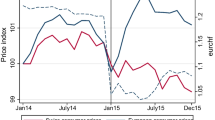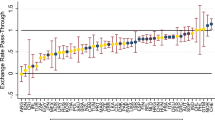Abstract
Previous studies that assessed the impact of exchange rate changes on a country’s inpayments and outpayments assumed that such effects are symmetric. The evidence from the literature reveals that import and export prices react to exchange rate changes in an asymmetric manner. This implies that export earnings and payments for imports should also react to exchange rate changes in an asymmetric manner. We demonstrate this by using Shin et al.’s (2014) nonlinear ARDL approach and inpayments and outpayments of the U.S. with her 15 trading partners. We find evidence of short-run as well as long-run asymmetric effects in more than half of the models, though the findings are found to be partner specific.
Similar content being viewed by others
Notes
Partners considered in this paper are: Australia (with 0.96% trade share), Belgium (1.4%), Canada (15.4%), Hong Kong (1.2%), China (16.0%), France (2.1%), Germany (4.7%), Italy (1.6%), Japan (5.2%), Korea (3.1%), Mexico (14.2%), Netherlands (1.5%), Singapore (1.3%), Switzerland (1.4%), U.K. (3.1%). Trade shares belong to 2015 and are defined as sum of the U.S. exports to and imports from a partner as a percent of sum of the U.S. exports to and imports from the World.
For a review article see Bahmani-Oskooee et al. (2013).
See Haynes et al. (1986, p. 931).
A stationary variable is usually denoted by I(0). Therefore, an I(1) variable is a variable that achieves stationarity after being differenced once.
As the Appendix shows the data are quarterly. In the absence of quarterly GDP data for most U.S. partners, we use index of industrial production as a measure of income. Also note that income elasticity in both models could be negative if increase in income is due to an increase in production of import-substitute goods (Bahmani-Oskooee 1986).
Another advantage of this approach is that it addresses simultaneity or feedback effects that may exist among the variables. The approach deals with the issue by assuming all lagged values to serve as instruments (Bahmani-Oskooee and Hajilee 2010, p. 650). Pesaran et al. (2001, p. 299) alert us to this issue by writing “our approach is quiet general in the sense that we can use a flexible choice for the dynamic lag structure in …..as well as allowing for short-run feedbacks.”
For more on the application of these methods see Delatte and Lopez-Villavicencio (2012), Verheyen (2013), Bahmani-Oskooee and Fariditavana (2015), Bahmani-Oskooee and Saha (2015), Gogas and Pragidis (2015), Durmaz (2015), Baghestani and Kherfi (2015), Pal and Mitra (2016), Al-Shayeb and Hatemi-J (2016), Lima et al. (2016), Nusair (2017), Aftab et al. (2017), and Gregoriou (2017).
The ECMt-1 test is an alternative test under which we use the normalized coefficients estimates and long-run model (1) to generate the error term, denoted by ECM. We then replace the lagged level variables in (3) by ECMt-1 and estimate the new specification after imposing the same optimum lag numbers from Panel A. A significantly negative coefficient estimate attached to ECMt-1 will support cointegration. Like the F test, Pesaran et al. (2001, p. 303) tabulate new critical values for the t test to be used in establishing significance of this estimate. For exact procedure see Bahmani-Oskooee and Ratha (2008).
In some models we had to include additional lags of the dependent variable in order to reduce the RESET statistic to an insignificant level.
As dollar appreciates against Australian dollar in real term, expensive U.S. goods does not hurt the U.S. export earnings due to an inelastic import demand by Australia.
Other statistics from panel C reveal that the residuals are autocorrelation free in almost all models since the LM statistic is insignificant. The RESET test is also insignificant in most models supporting lack of misspecification. Furthermore, most estimates are stable.
Other diagnostics are similar to those in Table 1.
Note that since trade flows are usually much more concentrated on specific goods than consumer good baskets, using the CPIs for the computation of real exchange rates is problematic. A better index would be GDP deflator. However, in the absence of GDP deflator at quarterly frequency for all countries, we restrict ourselves to CPI and acknowledge the bias in the results.
References
Aftab M, Ahmad R, Ismail I, Ahmed M (2017) Exchange rate volatility and Malaysian-Thai bilateral industry trade flows. J Econ Stud 44:99–114
Al-Shayeb A, Hatemi-J A (2016) Trade openness and economic development in the UAE: an asymmetric approach. J Econ Stud 43:587–597
Baghestani H, Kherfi S (2015) An error-correction modeling of US consumer spending: are there asymmetries? J Econ Stud 42:1078–1094
Bahmani-Oskooee M (1986) Determinants of international trade flows: the case of developing countries. J Dev Econ 20:107–123
Bahmani-Oskooee M, Fariditavana H (2015) Nonlinear ARDL approach, asymmetric effects and the J-curve. J Econ Stud 42:519–530
Bahmani-Oskooee M, Goswami G (2004) Exchange rate sensitivity of Japan's bilateral trade flows. Jpn World Econ 16:1–15
Bahmani-Oskooee M, Hajilee A (2010) On the relation between currency depreciation and domestic investment. Journal of Post Keynesian Economics 32:645–660
Bahmani-Oskooee M, Saha S (2015) On the relation between stock prices and exchange rates: a review article. J Econ Stud 42:707–732
Bahmani-Oskooee M, Ratha A (2008) Exchange rate sensitivity of US bilateral trade flows. Econ Syst 32:129–141
Bahmani-Oskooee M, Economidou C, Goswami G (2005a) How sensitive are the UK’s Inpayments and Outpayments to the value of the British pound. J Econ Stud 32:455–467
Bahmani-Oskooee M, Goswami G, Talukdar B (2005b) Exchange rate sensitivity of the Canadian bilateral Inpayments and Outpayments. Econ Model 22:745–757
Bahmani-Oskooee M, Harvey H, Hegerty S (2013) Empirical tests of the Marshall-Lerner condition: a literature review. J Econ Stud 40:411–443
Banerjee A, Dolado J, Mestre R (1998) Error-correction mechanism tests in a single equation framework. J Time Ser Anal 19:267–285
Bergstrand JH (1987) The U.S. trade deficit: A Perspective from Selected Bilateral Trade Models. New England Economic Review May–June Issue:19–31
Bussiere M (2013) Exchange rate pass-through to trade prices: the role of nonlinearities and asymmetries. Oxf Bull Econ Stat 75:731–758
Cushman DO (1987) U.S. bilateral trade balances and the dollar. Econ Lett 24:363–367
Delatte A-L, Lopez-Villavicencio A (2012) Asymmetry exchange rate pass-through: evidence from major countries. J Macroecon 34:833–844
Durmaz N (2015) Industry level J-curve in Turkey. J Econ Stud 42(4):689–706
Gogas P, Pragidis I (2015) Are there asymmetries in fiscal policy shocks? J Econ Stud 42:303–321
Gregoriou A (2017) Modelling non-linear behaviour of block price deviations when trades are executed outside the bid-ask quotes. J Econ Stud 44:206–213
Haynes SE, Hutchison MM, Mikesell RF (1986) U.S. -Japanese bilateral trade and the yen-dollar exchange rate: an empirical analysis. South Econ J 52:923–932
Lima L, Foffano Vasconcelos C, Simão J, de Mendonça H (2016) The quantitative easing effect on the stock market of the USA, the UK and Japan: an ARDL approach for the crisis period. J Econ Stud 43:1006–1021
Narayan PK (2005) The saving and investment nexus for China: evidence from Cointegration tests. Appl Econ 37:1979–1990
Nusair SA (2017) The J-curve phenomenon in European transition economies: a nonliear ARDL approach. Int Rev Appl Econ forthcoming
Pal D, Mitra SK (2016) Asymmetric oil product pricing in India: evidence from a multiple threshold nonlinear ARDL model. Econ Model 59:314–328
Pesaran HM, Shin Y, Smith RJ (2001) Bounds testing approach to the analysis of level relationships. J Appl Econ 16:289–326
Shin Y, Yu BC, and Greenwood-Nimmo M (2014). Modelling asymmetric Cointegration and dynamic multipliers in a nonlinear ARDL framework. R Sickels and W Horrace eds Festschrift in Honor of Peter Schmidt: Econometric Methods and Applications. Springer, New York, 281–314
Verheyen F (2013) Interest rate pass-through in the EMU-new evidence using nonlinear ARDL framework. Econ Bull 33(1):729–739
Author information
Authors and Affiliations
Corresponding author
Appendix
Appendix
1.1 Data definition and sources
Quarterly data over the 1970Q1-2015Q4 period are used to carry out the empirical exercise. The exception is China for which the data were only available during 1993I-2015IV period.
The data come from the following sources:
-
a.
Direction of Trade Statistics of IMF
-
b.
Federal Reserve Bank of St. Louis.
1.2 Variables
- VX i :
-
The U.S. inpayments (value of exports) from trading partner i. Export value data come from source a.
- VM i :
-
The U.S. outpayments (value of imports) to trading partner i. The data comes from source a.
- Y :
-
Measure of income in the United States. It is measured by the index of industrial production. This is the only measure of income that is available on quarterly basis for all countries. The data come from source b.
- Y i :
-
Measure of income in trade partner i. It is measured by the index of industrial production. The data come from source b.
- REX i :
-
The real bilateral exchange rate between the U.S. dollar and partner i’s currency. It is defined as REXi = (PUS. NEXi / Pi) where NEXi is the nominal exchange rate defined as number of i’s currency per dollar, PUS is the price level in the U.S. measured by CPI, and Pi is the price level in partner i, again measured by CPI. All nominal exchange rates and CPI data come from source b.
Thus, a decline in REX reflects a real depreciation of the United States dollar against i’s currency.Footnote 14
Rights and permissions
About this article
Cite this article
Bahmani-Oskooee, M., Fariditavana, H. How sensitive are the U.S. inpayments and outpayments to real exchange rate changes: an asymmetry analysis. Int Econ Econ Policy 16, 619–647 (2019). https://doi.org/10.1007/s10368-018-0411-0
Published:
Issue Date:
DOI: https://doi.org/10.1007/s10368-018-0411-0




